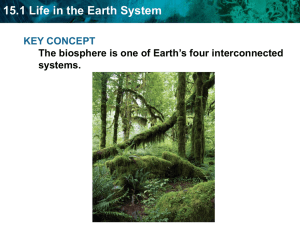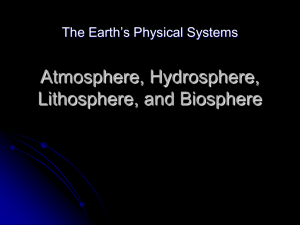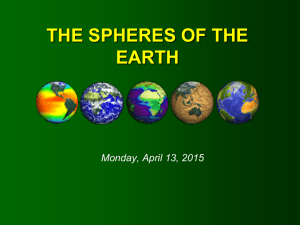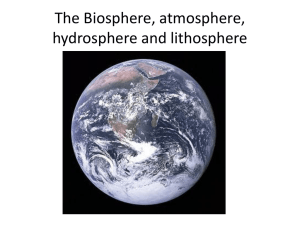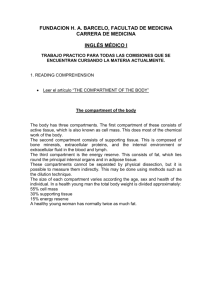Chemicals on earth are distributed among four major environmental
advertisement
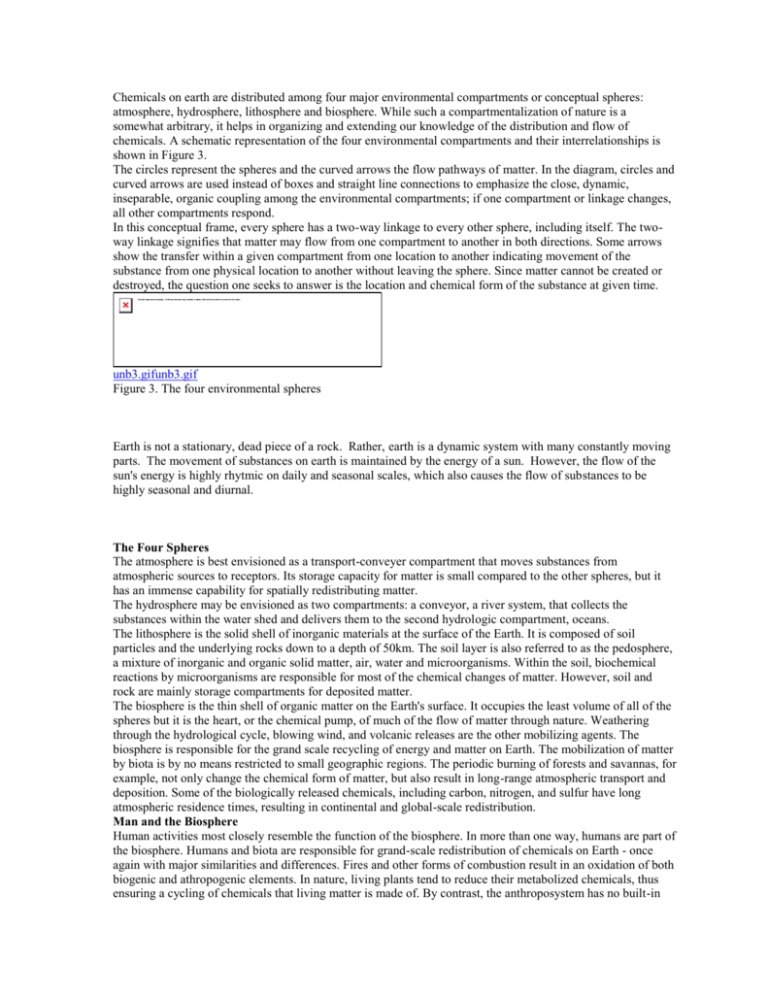
Chemicals on earth are distributed among four major environmental compartments or conceptual spheres: atmosphere, hydrosphere, lithosphere and biosphere. While such a compartmentalization of nature is a somewhat arbitrary, it helps in organizing and extending our knowledge of the distribution and flow of chemicals. A schematic representation of the four environmental compartments and their interrelationships is shown in Figure 3. The circles represent the spheres and the curved arrows the flow pathways of matter. In the diagram, circles and curved arrows are used instead of boxes and straight line connections to emphasize the close, dynamic, inseparable, organic coupling among the environmental compartments; if one compartment or linkage changes, all other compartments respond. In this conceptual frame, every sphere has a two-way linkage to every other sphere, including itself. The twoway linkage signifies that matter may flow from one compartment to another in both directions. Some arrows show the transfer within a given compartment from one location to another indicating movement of the substance from one physical location to another without leaving the sphere. Since matter cannot be created or destroyed, the question one seeks to answer is the location and chemical form of the substance at given time. unb3.gifunb3.gif Figure 3. The four environmental spheres Earth is not a stationary, dead piece of a rock. Rather, earth is a dynamic system with many constantly moving parts. The movement of substances on earth is maintained by the energy of a sun. However, the flow of the sun's energy is highly rhytmic on daily and seasonal scales, which also causes the flow of substances to be highly seasonal and diurnal. The Four Spheres The atmosphere is best envisioned as a transport-conveyer compartment that moves substances from atmospheric sources to receptors. Its storage capacity for matter is small compared to the other spheres, but it has an immense capability for spatially redistributing matter. The hydrosphere may be envisioned as two compartments: a conveyor, a river system, that collects the substances within the water shed and delivers them to the second hydrologic compartment, oceans. The lithosphere is the solid shell of inorganic materials at the surface of the Earth. It is composed of soil particles and the underlying rocks down to a depth of 50km. The soil layer is also referred to as the pedosphere, a mixture of inorganic and organic solid matter, air, water and microorganisms. Within the soil, biochemical reactions by microorganisms are responsible for most of the chemical changes of matter. However, soil and rock are mainly storage compartments for deposited matter. The biosphere is the thin shell of organic matter on the Earth's surface. It occupies the least volume of all of the spheres but it is the heart, or the chemical pump, of much of the flow of matter through nature. Weathering through the hydrological cycle, blowing wind, and volcanic releases are the other mobilizing agents. The biosphere is responsible for the grand scale recycling of energy and matter on Earth. The mobilization of matter by biota is by no means restricted to small geographic regions. The periodic burning of forests and savannas, for example, not only change the chemical form of matter, but also result in long-range atmospheric transport and deposition. Some of the biologically released chemicals, including carbon, nitrogen, and sulfur have long atmospheric residence times, resulting in continental and global-scale redistribution. Man and the Biosphere Human activities most closely resemble the function of the biosphere. In more than one way, humans are part of the biosphere. Humans and biota are responsible for grand-scale redistribution of chemicals on Earth - once again with major similarities and differences. Fires and other forms of combustion result in an oxidation of both biogenic and athropogenic elements. In nature, living plants tend to reduce their metabolized chemicals, thus ensuring a cycling of chemicals that living matter is made of. By contrast, the anthroposystem has no built-in mechanisms for reducing oxidized compounds. Rather, man-induced oxidation products have to rely on biota for reduction, i.e recycling. Given the limited reduction capacity of the biosphere, many of the combustion products remain in stable oxidized form and are ultimately deposited in another long-term geochemical reservoir. The atmosphere and the hydrosphere are effective conveyors of matter. Consequently, many of the anthropogenic chemicals are transferred to the land or the oceans where they are subsequently incorporated in these long-term geochemical reservoirs. Much of the environmental damage is done in the atmosphere, hydrosphere, lithosphere and biosphere during the transit from one long-term geochemical reservoir to another. The normal state of the earth that it is constantly changing. The changes occur at different scales at

